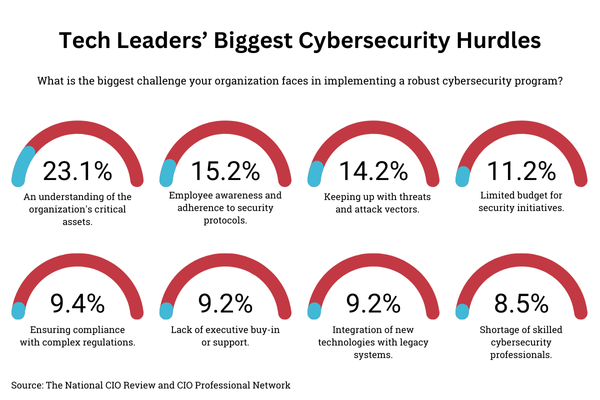Cybersecurity is more than a technical issue; it’s a strategic imperative, one that grows more complex as threats multiply and tactics evolve. For top technology executives, building a secure digital environment means confronting a range of challenges that go far beyond firewalls and encryption.
From managing budget constraints to aligning teams with security protocols, these leaders are tasked with protecting their organizations in a constantly shifting environment.
A recent survey conducted by The National CIO Review in collaboration with the CIO Professional Network, asked executives to pinpoint their greatest cybersecurity hurdles. Their responses reveal the most pressing obstacles—and why overcoming them is crucial to staying resilient amid increasingly sophisticated cyber threats.

Understanding the Organization’s Critical Assets (23.1%)
At the top of the list, understanding an organization’s critical assets is seen as the biggest challenge.
With 23.1% of executives identifying this as their primary concern, it highlights a foundational issue: without a clear view of what needs protecting, creating a targeted cybersecurity strategy is nearly impossible. This challenge underscores the importance of comprehensive asset inventory and classification processes.
Many organizations struggle to maintain up-to-date records of their digital assets, especially as they expand into the cloud or adopt new technologies. Without this clarity, security teams can overlook critical areas, leaving key systems exposed to potential attacks.
Employee Awareness and Adherence to Security Protocols (15.2%)
The human element continues to be a weak link in cybersecurity. Ranked second, 15.2% of technology leaders pointed to employee awareness and adherence to security protocols as a significant barrier.
Phishing attacks and social engineering scams target employees across all levels, exploiting lapses in protocol and awareness. While many organizations implement security training programs, the rapid evolution of cyber threats often outpaces the training provided.
This challenge emphasizes the need for continuous and adaptive training that engages employees, helping them recognize and respond to potential threats effectively.
Keeping Up with Threats and Attack Vectors (14.2%)
Cyber threats are not static; they evolve at a rapid pace, challenging security teams to keep up. 14.2% of respondents indicated that staying ahead of emerging threats and new attack vectors is a critical challenge.
From ransomware and phishing to increasingly sophisticated nation-state attacks, the range of potential threats demands constant vigilance and adaptation.
To tackle this challenge, many organizations are exploring threat intelligence services and advanced monitoring tools that provide real-time insights. However, the fast-paced nature of cyber threats makes it difficult for security teams to fully anticipate and prepare for every new tactic attackers use.
Limited Budget for Security Initiatives (11.2%)
Budget constraints are a perennial issue, with 11.2% of executives highlighting limited funding as a major obstacle.
Effective cybersecurity requires significant investment, not only in technology but also in skilled personnel and continuous training. For many organizations, especially smaller ones, the high costs associated with a comprehensive cybersecurity program pose a significant barrier. Executives often have to make hard choices about which aspects of their security program to prioritize.
This challenge reflects the importance of advocating for cybersecurity at the executive level and ensuring that the cost of potential breaches is factored into budget discussions.
Ensuring Compliance with Complex Regulations (9.4%)
With an increasing number of regulations such as GDPR, CCPA, and industry-specific compliance standards, keeping up with legal requirements is no small feat. Nearly 9.4% of respondents cited compliance as a substantial challenge.
Each regulatory framework brings its own set of requirements and nuances, adding complexity to cybersecurity strategies. The risk of non-compliance is significant, with financial penalties and reputational damage on the line.
Technology executives must often balance security needs with regulatory obligations, ensuring that policies and procedures meet both operational and compliance standards without stifling innovation.
Lack of Executive Buy-In or Support (9.2%)
Support from top leadership is essential for an effective cybersecurity program, yet 9.2% of executives reported a lack of executive buy-in as a significant hurdle.
Without backing from senior management, cybersecurity initiatives may struggle to gain the necessary resources and visibility within the organization. This challenge is particularly prevalent in organizations where cybersecurity is still seen as a purely IT issue rather than a strategic business concern.
A successful technology leader needs to be able to communicate the business impact of cyber risks and advocate for cybersecurity as a priority that protects both the organization’s assets and its reputation.
Integration of New Technologies with Legacy Systems (9.2%)
As organizations innovate, integrating new technologies with existing legacy systems presents unique security challenges, with 9.2% of executives highlighting this as a concern.
Legacy systems, which are often integral to an organization’s operations, may lack the security features needed to support modern defenses.
The integration process can introduce vulnerabilities, making these systems a prime target for cyberattacks. This issue emphasizes the need for strategic planning around technology adoption and integration, ensuring that legacy systems are adequately protected without compromising the functionality and value they provide to the organization.
Shortage of Skilled Cybersecurity Professionals (8.5%)
The talent gap in cybersecurity is a well-known issue, with 8.5% of executives identifying the shortage of skilled professionals as a challenge.
As cyber threats become more sophisticated, the demand for highly trained security personnel grows. However, there is a limited pool of skilled professionals who have the expertise needed to tackle complex security issues. This shortage forces organizations to compete for top talent, often stretching their budgets and resources.
In response, some companies are investing in training and development programs to build cybersecurity expertise from within their workforce, while others turn to automation to alleviate some of the burden on their security teams.
The Wrap
The insights from this survey reveal a series of interconnected challenges that technology executives face in creating strong and effective cybersecurity programs. From securing critical assets and addressing the human factor to budget limitations and regulatory demands, each obstacle highlights the multifaceted nature of modern cybersecurity.
As threats evolve and regulation continues to shift, it becomes clear that cybersecurity must be viewed as an organization-wide priority rather than just a technical issue. Organizations that succeed in overcoming these challenges are those that adopt a holistic approach—one that prioritizes asset understanding, employee training, executive support, and ongoing adaptation to today’s threats.
For those still catching up, these challenges underscore a critical truth: without proactive investment and bold, forward-thinking strategies, organizations risk falling behind as cyber threats grow increasingly relentless and unforgiving.






